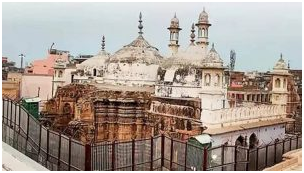Carbon Dating Of a ‘Shivling’ Inside Gyanvapi Mosque : Varanasi
News: The Archaeological Survey of India (ASI) was given permission by the Allahabad High Court to carbon date a “Shivling” found inside the Gyanvapi Mosque in Varanasi, Uttar Pradesh.
The object inside the Gyanvapi mosque, according to the petitioners, is a “Shivling.”
The Muslim side refuted the assertion, claiming that the object was a component of a “fountain”.
It overturned a Varanasi District Court ruling that denied a request for a scientific analysis of the structure, including carbon dating.
A common technique for determining the age of organic materials, or things that were once alive, is carbon dating.
Carbon exists in a variety of forms in all living things.
The carbon-14 (C-14) dating method is based on the fact that C-14 is radioactive and decays at a predictable pace.
The carbon isotope C-14 has an atomic mass of 14.
C-12 is the most prevalent form of carbon in the atmosphere.
There is also a tiny amount of C-14.
In the atmosphere, the ratio of C-12 to C-14 is almost constant and well-known.




